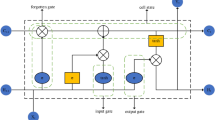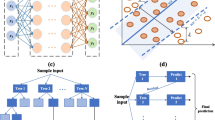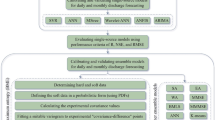Abstract
Accurate long-term runoff forecasting is crucial for managing and allocating water resources. Due to the complexity and variability of natural runoff, the most difficult problems currently faced by long-term runoff forecasting are the difficulty of model construction, poor prediction accuracy, and time intensive forecasting processes. Therefore, this study proposes a hybrid long-term runoff forecasting framework that uses the antecedent inflow and specific meteorological factors as the inputs, is modeled by ensemble empirical mode decomposition (EEMD) coupled with an artificial neural network (ANN), and computed by a parallel algorithm. First, the framework can transform monthly inflow and meteorological series into stationary signals via EEMD to more comprehensively explore the relationships of the input factors through the ANN. Second, the selected meteorological factors that are closely related to inflow formation can be filtered out by the single correlation coefficient method, which contributes to reducing coupling between input factors, and increases the accuracy of the prediction models. Finally, a multicore parallel algorithm that is easily accessed everywhere and that fully utilizes multiple calculation resources while flexibly contending with various optimization requirements will improve forecasting efficiency. The Xiaowan Hydropower Station (XW) is selected as the study area, and the final results of the study show that (1) the addition of targeted meteorological factors does indeed greatly enhance the performance of the prediction models; (2) the five criteria for evaluating the prediction accuracy show that the EEMD-ANN model is far superior to the prediction performance from the ordinary ANN model when run under the same input conditions; and (3) the optimization time of the 32-core model can be reduced by as much as 25 times, which significantly saves time during the forecast process.




Similar content being viewed by others
Data Availability
Data, models, or code that support the findings of this study are available from the corresponding author upon reasonable request.
References
Callegari M, Mazzoli P, Pistocchi A (2015) Seasonal river discharge forecasting using support vector regression: a case study in the italian alps. Water 7(5):2494–2515. https://doi.org/10.3390/w7052494
Chau KW (2006) Particle swarm optimization training algorithm for ANNs in stage prediction of Shing Mun River. J Hydrol 329(3–4):363–367. https://doi.org/10.1016/j.jhydrol.2006.02.025
Chau KW, Wu CL, Li YS (2005) Comparison of several flood forecasting models in yangtze river. J Hydroelectr Eng 10(6):485–491. https://doi.org/10.1061/(ASCE)1084-0699(2005)10:6(485)
Fahimi F, El-Shafie AH (2014) Comment on “a hybrid model of self organizing maps and least square support vector machine for river flow forecasting” by Ismail et al. Hydrol Earth Syst Sci 18(7):2711–2714. https://doi.org/10.5194/hess-18-2711-2014
He S, Sang XF, Yin JX, Zheng Y, Chen HT (2022) Short-term runoff prediction optimization method based on bgru-bp and blstm-bp neural networks. Water Resour Manag. https://doi.org/10.1007/s11269-022-03401-z
Khader AI, Rosenberg DE, McKee M (2013) A decision tree model to estimate the value of information provided by a groundwater quality monitoring network. Hydrol Earth Syst Sci 17(5):1797–1807. https://doi.org/10.5194/hess-17-1797-2013
Li FF, Wang ZY, Zhao X, Xie E, Qiu J (2019) Decomposition-ANN methods for long-term discharge prediction based on fisher’s ordered clustering with MESA. Water Resour Manag 33(9):3095–3110. https://doi.org/10.1007/s11269-019-02295-8
Li KF, Ji CM, Zhang YK, Xie W, Zhang XX (2012) Study of mid and long-term runoff forecast based on back-propagation neural network. 188–191. https://doi.org/10.1109/ICICEE.2012.57
Li WT, Duan QY, Miao CY, Ye AZ, Gong W, Di ZH (2017) A review on statistical postprocessing methods for hydrometeorological ensemble forecasting. Wiley Interdiscip Rev Water 4(6). https://doi.org/10.1002/wat2.1246
Liao SL, Li G, Sun QY, Li ZF (2016) Real-time correction of antecedent precipitation for the Xinanjiang model using the genetic algorithm. J Hydroinform 18(5):803–815. https://doi.org/10.2166/hydro.2016.168
Liao SL, Liu ZW, Liu BX, Cheng CT, Jin XF, Zhao ZP (2020) Multistep-ahead daily inflow forecasting using the ERA-Interim reanalysis data set based on gradient-boosting regression trees. Hydrol Earth Syst Sci 24(5):2343–2363. https://doi.org/10.5194/hess-24-2343-2020
Lin JY, Cheng CT, Chau KW (2006) Using support vector machines for long-term discharge prediction. Hydrology Sci J 51(4):599–612. https://doi.org/10.1623/hysj.51.4.599
Lu D, Zhou HC (2014) Medium and long-term runoff forecasting based on mutual information and bp neural network. J China Hydrol 34(4):8–14
Ma F, Yuan X, Ye AZ (2015) Seasonal drought predictability and forecast skill over China. J Geophys Res Atmos 120(16):8264–8275. https://doi.org/10.1002/2015JD023185
Ma YF, Zhong PA, Xu B, Zhu FL, Li JY, Wang H, Lu QW (2021) Cloud-based multidimensional parallel dynamic programming algorithm for a cascade hydropower system. Water Resour Manag 35(9):2705–2721. https://doi.org/10.1007/s11269-021-02859-7
Martin G, Frederik K, Daniel K, Grey N, Jimmy L, Sepp H (2020) Rainfall–runoff prediction at multiple timescales with a single Long Short-Term Memory network. Hydrol Earth Syst Sci 25:2045–2062. https://doi.org/10.5194/hess-25-2045-2021
Niu WJ, Feng ZK, Feng BF, Xu YS, Min YW (2021) Parallel computing and swarm intelligence based artificial intelligence model for multi-step-ahead hydrological time series predictio. Sustain Cities Soc 66. https://doi.org/10.1016/j.scs.2020.102686
Ravindran SM, Bhaskaran SKM, Ambat SKN (2021) A deep neural network architecture to model reference evapotranspiration using a single input meteorological parameter. Environ Process 8:1567–1599. https://doi.org/10.1007/s40710-021-00543-x
Shoaib M, Shamseldin AY, Khan S, Khan MM, Khan ZM, Sultan T, Melville BW (2018) A comparative study of various hybrid wavelet feedforward neural network models for runoff forecasting. Water Resour Manag 32(1):83–103. https://doi.org/10.1007/s11269-017-1796-1
Sun QH, Miao CY, Duan QY, Ashouri H, Sorooshian S, Hsu K-L (2018) A review of global precipitation data sets: Data sources, estimation, and intercomparisons. Rev Geophys 56(1):79–107. https://doi.org/10.1002/2017RG000574
Tan QF, Lie XH, Wang X, Wang H, Wen X, Ji Y, Kang AQ (2018) An adaptive middle and long-term runoff forecast model using EEMD-ANN hybrid approach. J Hydrol 576:767–780. https://doi.org/10.1016/j.jhydrol.2018.01.015
Wang WC, Xu DM, Chau KW, Chen SY (2013) Improved annual rainfall-runoff forecasting using PSO–SVM model based on EEMD. J Hydroinf 15(4):1377–1390. https://doi.org/10.2166/hydro.2013.134
Wang WC, Chau KW, Qiu L, Chen YB (2015) Improving forecasting accuracy of medium and long-term runoff using artificial neural network based on EEMD decomposition. Environ Res 139:46–54. https://doi.org/10.1016/j.envres.2015.02.002
Wang YT, Liu J, Li R, Suo XY, Lu EH (2022) Medium and long-term precipitation prediction using wavelet decomposition-prediction-reconstruction model. Water Resour Manag 36(3):971–987. https://doi.org/10.1007/s11269-022-03063-x
Wang WC, Nie XT, Qiu L (2010) Support vector machine with particle swarm optimization for reservoir annual inflow forecasting. IEEE:184–188. https://doi.org/10.1109/AICI.2010.45
Xie XY, Tang HH, Wang JP, Li CH, Chen J, An W, Hu BX (2016) Runoff forecasting model in flood season based on weather factors. J Paper 33(10):12–14
Yue ZX, Ai P, Xiong CS, Song YH, Hong M, Yu JR (2020) Mid and long-term runoff forecasting based on improved deep belief networks model. J Hydroelectr Eng 39(10):33–46
Zhang X, Zhang XN, Wang GX, Wu W, Xu Y (2021) Medium and long-term forecast of the reservoir inflow in the upper yangtze river. Water Resour Protect 38(4):131–136
Zhao XY, Ping A, Ding BY, Chuan SX (2020) Ensemble approach for mid-long term runof forecasting using hybrid algorithms. J Ambient Intell Humaniz Comput. https://doi.org/10.1007/s12652-020-02345-9
Funding
This work was supported by the National Natural Science Foundation of China [grant number 51979023].
Author information
Authors and Affiliations
Contributions
S. L. performed study design, data analysis and interpretation, and drafted the manuscript. H. W. and B.L. participated in the study design, data collection, algorithm and manuscript preparation. X M. participated in the design and coordination of experimental work. B.Z. and H.S. performed data collection and interpretation. All authors read and approved the final manuscript.
Corresponding author
Ethics declarations
Ethics Approval
Not applicable.
Consent to Participate
Not applicable.
Consent to Publish
Not applicable.
Competing Interests
The authors declare that they have no conflict of interest.
Additional information
Publisher's Note
Springer Nature remains neutral with regard to jurisdictional claims in published maps and institutional affiliations.
Rights and permissions
Springer Nature or its licensor (e.g. a society or other partner) holds exclusive rights to this article under a publishing agreement with the author(s) or other rightsholder(s); author self-archiving of the accepted manuscript version of this article is solely governed by the terms of such publishing agreement and applicable law.
About this article
Cite this article
Liao, S., Wang, H., Liu, B. et al. Runoff Forecast Model Based on an EEMD-ANN and Meteorological Factors Using a Multicore Parallel Algorithm. Water Resour Manage 37, 1539–1555 (2023). https://doi.org/10.1007/s11269-023-03442-y
Received:
Accepted:
Published:
Issue Date:
DOI: https://doi.org/10.1007/s11269-023-03442-y




